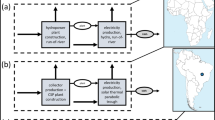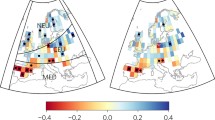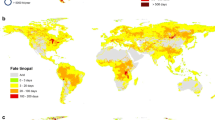Abstract
Purpose
Thermal emissions from electric power generation plants can lead to environmental impacts. However, such emissions have neither been comprehensively integrated in life cycle assessment (LCA), a method to quantify environmental impacts throughout the life cycle of a product, nor in water footprinting. This study presents a spatially explicit (0.5 arc degree resolution) fate and effect model for assessing the impact of thermal emissions from power production in the USA on freshwater ecosystems.
Methods
We developed a two-step regionalized fate model to capture short-range and long-range thermal effects. Effect factors were derived as a function of ambient temperature and used in conjunction with the fate factor to calculate the impacts. The impacts are measured as the potentially disappeared fraction (PDF) of species in the affected freshwater ecosystem volume over time.
Results and discussion
The long-range freshwater ecosystem impacts are dependent on the distance to sea as well as the ambient temperature, while the short-range effects are mainly influenced by the induced temperature change at the point of mixing. Our analysis showed that 95 % of the modeled grid cells in the USA have an impact of 2.5 × 10−6 to 2.5 × 10−4 PDF m3 years per MJ emitted heat. For natural gas power production, thermal pollution can have a significant contribution to total freshwater ecosystem quality.
Conclusions
This study shows that thermal effects can be calculated on a spatially explicit level based on background data. It reveals the variability within a large region of the world, covering various geographic regions, and therefore helps generalizing the results for other regions.



Similar content being viewed by others
References
Allen PM, Arnold JC, Byars BW (1994) Downstream channel geometry for use in planning-level models. JAWRA J Am Water Resour Assoc 30:663–671
Bauer CHT, Dones R, Mayer-Spohn O, Blesl M (2008) New Energy Externalities Developments for Sustainability (NEEDS), Deliverable n° 7.2 - RS 1a “Final report on technical data, costs, and life cycle inventories of advanced fossil power generation systems”
de Vries P, Tamis JE, Murk AJ, Smit MGD (2008) Development and application of a species sensitivity distribution for temperature-induced mortality in the aquatic environment. Environ Toxicol Chem 27:2591–2598
Deas ML, Lowney CL (2000) Water temperature modeling review—Central Valley. California Water and Environmental Modeling Forum
EAWAG (1997) Auswirkungen des Kernkraftwerkes Mühleberg auf den Wärmehaushalt der Aare. GBL, EAWAG, Dübendorf
ecoinvent Centre (2010) ecoinvent data v2.2. http://www.ecoinvent.org. Accessed 20 Feb 2012
ESRI (2007) ArcGIS 9.2
Fekete BM, Vörösmarty CJ, Grabs W (2002) High-resolution fields of global runoff combining observed river discharge and simulated water balances. Glob Biogeochem Cycles 16:15-11-15-10
Finkbeiner M (2009) Carbon footprinting—opportunities and threats. Int J Life Cycle Assess 14:91–94
Goedkoop M, Spriensma R (2001) The Eco-indicator 99: a damage oriented method for life cycle impact assessment: methodology report. Publikatiereeks produktenbeleid; nr. 36A, vol 3rd edition. Ministerie van Volkshiusvesting, Ruimtelijke Ordening en Milieubeheer, Den Haag
Goedkoop M, Heijungs R, Huijbregts M, De Schryver A, Struijs J, van Zelm R (2009) ReCiPe 2008—a life cycle impact assessment method which comprises harmonised category indicators at the midpoint and the endpoint level. Available at http://lcia.wik.is
Humbert S, De Schryver A, Bengoa X, Margni M, Jolliet O (2012) IMPACT 2002+: user guide draft for version Q2.21 (version adapted by Quantis). Available at: http://www.quantis-intl.com/pdf/IMPACT2002_UserGuide_for_vQ2.21.pdf
ISO (2006) ISO 14044: environmental management—life cycle assessment—requirements and guidelines. International Organization for Standardization, Geneva
ISO (2013) ISO 14067: Greenhouse gases—carbon footprint of products—requirements and guidelines for quantification and communication
ISO (2014) ISO 14046 Environmental management—water footprint—principles, requirements and guidelines
JRC (2011) International Reference Life Cycle Data System (ILCD) Handbook—recommendations for life cycle impact assessment in the European context, 1st edn. European Commission-Joint Research Centre - Institute for Environment and Sustainability, Luxemburg
Kounina A et al (2013) Review of methods addressing freshwater use in life cycle inventory and impact assessment. Int J Life Cycle Assess 18:707–721
Miara A, Vörösmarty CJ, Stewart RJ, Wollheim WM, Rosenzweig B (2013) Riverine ecosystem services and the thermoelectric sector: strategic issues facing the Northeastern United States. Environ Res Lett 8:025017
Pfister S, Koehler A, Hellweg S (2009) Assessing the environmental impacts of freshwater consumption in LCA. Environ Sci Technol 43:4098–4104
Rosenbaum RK et al (2008) USEtox-the UNEP-SETAC toxicity model: recommended characterisation factors for human toxicity and freshwater ecotoxicity in life cycle impact assessment. Int J Life Cycle Assess 13:532–546
Roy P-O, Deschênes L, Margni M (2014) Uncertainty and spatial variability in characterization factors for aquatic acidification at the global scale. Int J Life Cycle Assess 19(4):882–890
Tendall DM, Hellweg S, Pfister S, Huijbregts MAJ, Gaillard G (2014) Impacts of river water consumption on aquatic biodiversity in life cycle assessment—a proposed method, and a case study for Europe. Environ Sci Technol 48(6):3236–3244
USGS Surface-Water Data for the Nation (2011) http://waterdata.usgs.gov/nwis/sw. Accessed 11 Sept 2011
van Vliet MTH, Yearsley JR, Franssen WHP, Ludwig F, Haddeland I, Lettenmaier DP, Kabat P (2012) Coupled daily streamflow and water temperature modelling in large river basins. Hydrol Earth Syst Sci 16:4303–4321
Verones F, Hanafiah MM, Pfister S, Huijbregts MAJ, Pelletier GJ, Koehler A (2010) Characterization factors for thermal pollution in freshwater aquatic environments. Environ Sci Technol 44:9364–9369
Verones F, Mohd Hanafiah M, Pfister S, Huijbregts MAJ, Pelletier GJ, Koehler A (2011) Correction to characterization factors for thermal pollution in freshwater aquatic environments. Environ Sci Technol 45:7608
Verones F, Saner D, Pfister S, Baisero D, Rondinini C, Hellweg S (2013) Effects of consumptive water use on biodiversity in wetlands of international importance. Environ Sci Technol 47:12248–12257
WorldClim (2011) Global climate data; data for current conditions (∼1950-2000). http://www.worldclim.org/current. Accessed 6 Au g 2011
Acknowledgments
The authors thank Catherine Raptis, Ronnie Juraske, Danielle Tendall, Francesca Verones, Stefanie Hellweg, and Mark Huijbregts for their helpful inputs and discussions and ExxonMobil Research and Engineering for partially funding this research project. The views expressed in this paper are solely those of the authors.
Author information
Authors and Affiliations
Corresponding author
Additional information
Responsible editor: Masaharu Motoshita
Electronic supplementary material
Below is the link to the electronic supplementary material.
ESM 1
(DOCX 5582 kb)
Rights and permissions
About this article
Cite this article
Pfister, S., Suh, S. Environmental impacts of thermal emissions to freshwater: spatially explicit fate and effect modeling for life cycle assessment and water footprinting. Int J Life Cycle Assess 20, 927–936 (2015). https://doi.org/10.1007/s11367-015-0893-8
Received:
Accepted:
Published:
Issue Date:
DOI: https://doi.org/10.1007/s11367-015-0893-8




